Table of contents
Vegetable margarine is also known as artificial butter , oleo-margarine or margarine and is an industrially produced spreadable fat. It is a vegan alternative to butter, but its health benefits are still controversial. Almond puree ( almond butter ) is often a suitable unrefined, organic and natural alternative.
Use in the kitchen:
Vegetable margarine (vegetable butter) can be used as a spread in the same way as butter. Whether on bread, pastries, crispbread or in spreads, the use is 1:1. Butter can also be easily replaced with vegetable margarine when baking cakes or biscuits where solid fat is required (such as with shortcrust pastry). For many cakes, it is also possible to add heatable oil (such as refined rapeseed oil ) instead of butter or margarine, but in a slightly different ratio.
Margarine can only be used for frying to a limited extent, as it usually has a higher water content than butter, for example. Margarine (full-fat margarine) must have a fat content of at least 80 and max. 90% 1 , in which case slow heating and frying is OK, e.g. for baking pancakes or omelettes. The smoke point is similar to butter at around 160-175 °C. Three-quarter fat margarine (60-62% fat) or half fat margarine (39-41% fat) must be labelled accordingly and are not suitable for heating.
Vegan recipe for herb butter with vegetable margarine:
Ingredients: 250 g vegan vegetable margarine, 1 bunch of fresh herbs (e.g. wild garlic , chives , basil , sage ), 2 cloves of garlic , 1 teaspoon salt (or less), 1 teaspoon tarragon .
Preparation: Allow the margarine to soften at room temperature, add finely chopped herbs, pressed or chopped garlic cloves and salt and mix well. Pour the butter into a suitable container and refrigerate until ready to use. To add some variety to the vegan herb butter, you can refine the margarine with 1-2 tablespoons of tomato paste and basil.
Vegan recipe for mustard sauce with vegetable margarine:
Ingredients: 4 tablespoons vegan vegetable margarine, 3 tablespoons wheat flour , 450 ml vegetable stock , 3 tablespoons mustard , paprika powder (sweet ), sea salt ,pepper .
Preparation: Melt the margarine in a pan and stir the flour into the margarine using a whisk (whisk, foamer). Now add a little vegetable stock while stirring constantly. If the sauce thickens, add more vegetable stock until it is all used up. It is important to stir constantly so that no lumps form. Add mustard and season the sauce with paprika, salt and pepper. Reduce the heat a little and let the sauce simmer for another 3-4 minutes, stirring occasionally.
To make the mustard sauce even creamier, you can use a plant-based drink, such as oat drink , instead of vegetable stock. This sauce tastes very good with boiled potatoes or vegetables such as cauliflower or spinach .
Vegan recipes with vegetable margarine can be found under the note: " Recipes that have the most of this ingredient ".
| Not only vegans or vegetarians should read this: Vegans often eat unhealthily. Avoidable nutritional mistakes . |
Shopping - where to buy "vegan butter"?
Purely vegetable margarine is available in most supermarkets such as Coop , Migros , Denner , Volg , Spar , Aldi , Lidl , Rewe , Edeka , Hofer etc. In selected supermarkets also in organic quality. Organic products can definitely be found in health food stores, organic shops, organic supermarkets ( Denn's Biomarkt , Alnatura ) or in online shops. Organic vegetable margarine usually contains no artificial flavors, salt or preservatives. Organic margarine without hydrogenated fats: Organic vegetable margarine is not chemically hydrogenated and must not contain any genetically modified ingredients. According to the EC organic regulation, however, up to 5% of the ingredients contained may come from non-controlled organic farming.
Is margarine vegan? or Which margarine is vegan? An emulsion of vegetable and/or animal fats is called margarine. Margarine can also contain animal substances such as whey products, lactose or skimmed milk. In addition to milk fat, animal fats such as beef tallow or fish oil are also permitted. So read the ingredients list carefully and look for vegan margarine (vegetable butter). Be careful with sour whey, which often appears as an additive in margarines but is a dairy product: there is no such thing as "vegan sour whey".
You can also identify margarine without hydrogenated fats (margarine without trans fatty acids or margarine without trans fats) by looking at the list of ingredients: If hydrogenated fats (margarine trans fats) are present, this must be declared.
Margarine without palm oil: Make sure that your "vegan butter" does not contain palm oil . In addition to the ecological reasons of rainforest destruction, there is evidence that the production of refined palm oil produces carcinogenic and genotoxic substances (3-MCPD, 2-MCPD and glycidyl fatty acid esters). 2
For pure vegetable margarine, the fat content must consist of 97% vegetable fats and the linoleic acid content must be at least 15%. Reform margarines are particularly low in sodium chloride and must not contain any hydrogenated fats. 3 Healthy margarine? The best margarine is vegan margarine without palm fat and hydrogenated fats (trans fat margarine: see also öko test margarine). It is even healthier to avoid margarine and butter.
Making your own vegan vegetable margarine:
How do you make margarine? For about 150 g of vegan vegetable margarine you need 120 ml of refined rapeseed oil , 40 g of cocoa butter and a pinch of crystal salt.
Preparation: Melt the cocoa butter in a pan, add the rapeseed oil and salt and stir well. Pour the mixture into a mixing bowl and place in the fridge. The margarine needs about 3 hours to harden. Then take the mixture out of the fridge and stir again with a hand mixer until smooth. Now you can pour the margarine into a small, sealable container (e.g. jar, tin) and place in the fridge. It will keep there for about 3 weeks.
Storage:
Vegetable margarine without trans fats should be stored in the refrigerator at around 5-7 °C, and will last for several weeks. Frozen in the freezer, it will last for around a year, but it must be thawed well before use so that it is spreadable.
Margarine - Ingredients - Nutritional value - Calories:
The composition of a margarine corresponds to an oil-in-water emulsion with an average ratio of 80:20. 4 With this fat content (80%), the calorie content per 100 g is approximately 719 kcal. The proportion of saturated fats is approximately 17%, carbohydrates and proteins are contained at less than 1%.
Table salt is not naturally present, but is added afterwards and the salt content can vary greatly depending on the type of margarine. According to the USDA, the table salt content is around 2,395 mg/100g. The sodium content is very high at 943 mg/100g and is in a similar range to that of the algae Wakame (872 mg/100g) and Spirulina (1,048 mg/100g, actually cyanobacteria). Table salt should only be used very sparingly, because if you do not eat a natural diet you will consume far too much. 5
Vitamins are also added to margarines, as the naturally contained vitamins are lost during the manufacturing process. Most margarines contain around 819 µg/100g of vitamin A. This is a similar value to that found naturally in carrots : 835 µg/100g. Sweet potatoes are also in a similar range at 709 µg/100g. This fat-soluble vitamin is contained in substances such as retinol and beta-carotene, which are mainly found in vegetables. In dried products such as sweet paprika powder, the content is concentrated and amounts to 6,042 µg/100g. Vitamin A is important for good eyesight. 5
The amount of vitamin E in vegetable margarine is around 3.1 mg/100g, which is comparable to sea buckthorn berries (3 mg/100g) or pointed peppers (2.9 mg/100g). Almonds have significantly more of it (26 mg). The fat-soluble vitamin has an important role as an antioxidant. Vitamin E is relatively heat-stable, and losses are moderate even after heating for several hours at up to 180 °C. 5
Margarine also contains added calcium . The content of 30 mg/100g is similar to that of butter. This value is comparable to that of clementines , sauerkraut and blackberries . In comparison, dried herbs have a particularly high calcium content, for example dried basil has 2,240 mg/100g. Calcium, an essential macronutrient, is important for good stability of bones and teeth. 5
Margarine contains fatty acids such as linoleic acid and alpha-linolenic acid (ratio 13:1) as well as all 8 essential amino acids, such as tryptophan , valine , lysine , etc. 5
In addition to vegetable oil or fat, water, table salt and vitamins, vegetable margarine often also contains emulsifiers (lecithin E322, monoglycerides and diglycerides of fatty acids E471), preservatives (potassium sorbate E202), acidifiers (citric acid E330), flavourings and colourings (carotene E160, usually β-carotene E160a). Hydrogenated or partially hydrogenated fats are always questionable and you should therefore never buy margarines with such ingredients.
The complete ingredients of vegetable margarine, the coverage of the daily requirement and comparison values with other ingredients can be found in our nutrient tables. In the article Nutrients explained you will get a detailed insight into the topic. CLICK FOR before the text.
Health aspects - effects:
Saturated fatty acids promote cardiovascular diseases because they increase the cholesterol level in the blood. For example, vegetable margarine can be healthier for people with high blood fat levels than butter, for example, because it contains a higher proportion of polyunsaturated fatty acids. But not all margarine is the same here either, because there are also types of margarine that contain a lot of saturated fatty acids. But cholesterol and saturated fatty acids are not the only factors responsible for the development of cardiovascular diseases. Isolated carbohydrates (sugar, flour) in baked goods and pasta, sweets, etc. also play a significant role. A combination of both or replacing fat with readily available carbohydrates is the wrong approach here. 6
Can you even lower cholesterol with margarine? This effect is said to be achieved by added plant sterols, which are related to cholesterol and therefore compete with it for absorption. To achieve this effect, however, you would have to eat a lot of margarine (30 g daily) over a long period of time. However, these sterols are not entirely harmless, as they make it difficult to absorb fat-soluble vitamins and are also said to promote deposits in the blood vessels. 7
Which margarine is the healthiest? High-quality, purely vegetable margarines are naturally cholesterol-free, gluten-free and lactose-free. However, it is also important to pay attention to the trans fat content and the ratio of omega-6 to omega-3 fatty acids.
If you compare butter with margarine (artificial butter, spread), there is no clear health benefit in regular margarine. The industrial production and the addition of vitamins make margarine look worse than natural butter made from raw milk. It is advisable to use it sparingly or to avoid it for both types.
Dangers - intolerances - side effects:
What is so unhealthy about margarine? Despite physiological adaptations, vegetable margarine is an industrial product and its health value remains controversial.
Free MCPD (3- and 2-monochloropropanediol) and their esters as well as glycidyl fatty acid esters are formed during the production of vegetable fats and oils. These fatty pollutants have been detected in some types of margarine. Low-fat margarines have a lower value due to the higher water content. High heating removes unpleasant, bitter odors and flavors, with MCPD fatty acid esters being formed at 150 °C and glycidyl fatty acid esters at 200 °C. These esters can also form during the processing of animal foods, e.g. when toasting, grilling, frying or smoking. 8
3-MCPD is considered potentially carcinogenic to humans. The limit of 0.8 µg/kg body weight per day was corrected to 2 µg/kg body weight per day in 2018. There is no official limit for 2-MCPD and there are no studies on its effects on the body. The body breaks down glycidyl fatty acid esters and releases glycidol, which according to EFSA ( European Food Safety Authority ) and JECFA ( FAO/WHO Expert Committee on Food Additives ) is classified as carcinogenic and mutagenic. There is no tolerated intake level at which negative health consequences can be ruled out. 8
These substances can also be found in baked goods and confectionery, spreads (chocolate spreads, peanut butter), fried products, snack products (pretzels, potato chips) and baby food. Palm oil contains the highest concentrations, but other vegetable oils such as coconut oil, walnut oil ,sunflower oil , soybean oil, rapeseed oil and margarine are also very dangerous if these oils are refined at high temperatures. The daily tolerable amount can be a danger, especially for children, as this is usually quickly exceeded with one portion of the above-mentioned products. 8
When liquid oils are hardened to form solid fats, trans fatty acids (TFA) can be formed. Compared to the past, when trans fat levels were around 15-25%, they are now significantly lower at 0-2%. The recommendation is not to consume more than 2 g of trans fatty acids per day, or no more than 1% of the dietary energy. If the daily intake of trans fatty acids exceeds 2% of the dietary energy, the risk of cardiovascular disease increases. 9 High-quality margarine also contains fewer trans fats.
Trans fats or trans fatty acids cause LDL cholesterol to rise and HDL to fall, which can lead to arteriosclerosis and subsequently to heart attacks or strokes. 10,11 In addition, trans fats have a detrimental effect on the brain and nervous system, affecting performance, increasing the risk of depression and possibly also playing a role in the development of Alzheimer's. 12
Margarine is not a good source of omega-3 fatty acids, in fact the opposite, as the ratio of omega-6 to omega-3 fatty acids is around 13:1, although a ratio of 1:1 would be optimal and 5:1 would be a goal. Cold-pressed linseed oil performs excellently with a LA:ALA ratio of 1:4. Cold-pressed rapeseed oil has a very good ratio of omega-6 to omega-3 fatty acids at 2:1. In contrast, cold-pressed olive oil has a ratio of 12:1, which is just as bad as margarine. Read more about this in the box link above, in the article " Vegans often eat unhealthily. Avoidable nutritional mistakes ".
Metal catalysts are often used in the hydrogenation process, and traces of nickel and aluminum can pass into the margarine. Although the nickel content is usually below the detection limit of 0.02 mg/kg and is therefore considered harmless 13 , there have been repeated cases where the content was significantly higher. A study of Polish margarines in 2012 found that the nickel content in 7 of the 10 margarine brands examined was significantly higher than 0.2 mg/kg. 14 These values can lead to allergic reactions in sensitive people. Unfortunately, there is no precisely defined maximum value for nickel in food. The Drinking Water Ordinance has set a maximum nickel value of 0.02 mg/l, and for materials used in consumer goods that come into contact with food, the value is 0.14 mg nickel/kg of food. Nickel and nickel compounds have been classified as carcinogenic to humans. However, the European Food Safety Authority ( EFSA ) considers the intake of nickel through food to be harmless. 15
Occurrence - Origin:
The original idea of margarine goes back to Napoleon III, who was looking for a longer-lasting alternative to butter for his troops. In 1869, the chemist Hippolyte Mège-Mouriès successfully invented and patented the beurre économique ("cheap butter"), later called margarine Mouriès. At that time, milk, water, kidney fat and, at the beginning, rennet or crushed cow's udder were used. 16
Industrial production:
Wikipedia lists the following process steps for the large-scale production of margarine (artificial butter): pressing the oilseed and extracting the vegetable oil (e.g. sunflower seeds, cottonseed, rapeseed, etc.); extracting the oil with solvents to remove impurities, colorants and provitamins (e.g. with hexane and water); degumming to liquefy the consistency (e.g. with phosphoric acid); deacidification to remove unwanted fatty acids (e.g. with caustic soda); bleaching to remove unwanted colorants (e.g. with bleaching earth); filtering to remove unwanted components and steaming to remove unwanted flavors. The now tasteless and colorless vegetable oil is mixed with other vegetable fats, colorants (carotene), flavorings (salt, milk) and vitamins (vitamin E, vitamin A, vitamin D). In order to adjust the spreadability, the last step in the production of conventional margarine is fat hardening and transesterification using nickel and hydrogen. This spreadability can also be achieved using emulsifiers, thickeners or milk protein, and often also by hydrogenating the fats.
Organic margarines or reform margarines are not subjected to chemical fat hardening, nor may they contain any chemical additives or auxiliary substances. The spreadability of organic margarines is usually regulated by physical methods such as cold processes, water or steam or by adding natural solid fats such as palm or coconut oil.
General information:
In the past, a food coloring made from azo dyes, butter yellow (CI Solvent Yellow 2, dimethylaminoazobenzene), was used to give margarine its buttery color. Since this has been classified as carcinogenic and banned, carotenoids (E160a-g and E161a-h) are now used almost exclusively to achieve a yellowish color.
Alternative names:
In addition to the names mentioned at the beginning of the article, brand names such as Rama, Becel, Lätta, Sanella etc. are also often used for margarine without palm oil - or: Sojola, Goldina, Soyatoo Tofu Butter, Cocovit Bio etc. But vegan butter, vegan block or vegetable butter are also often used trivial names for vegetable margarine.
The English language uses the terms oleomargarine or oleomargarin, plant-based margarine or vegetable margarine, the French language uses oléomargarine, margarine végétale or beurre végétal.
Literature - Sources:

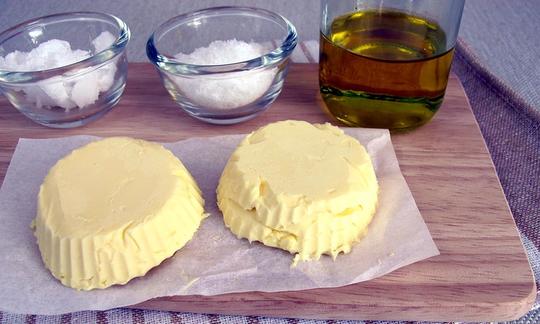

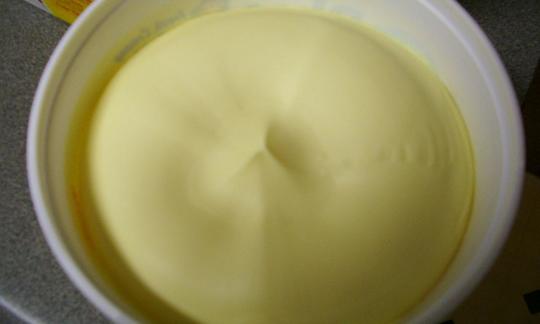

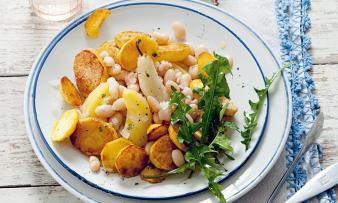

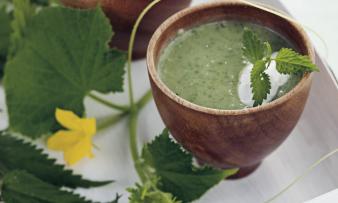


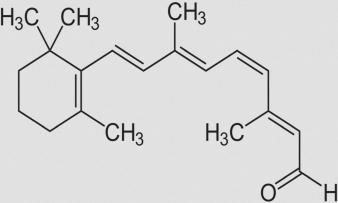


Comments